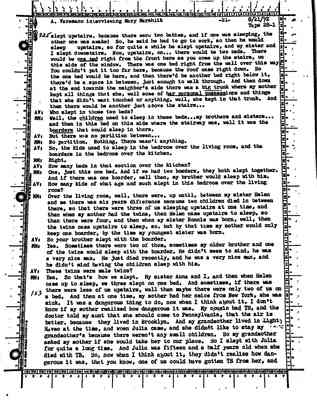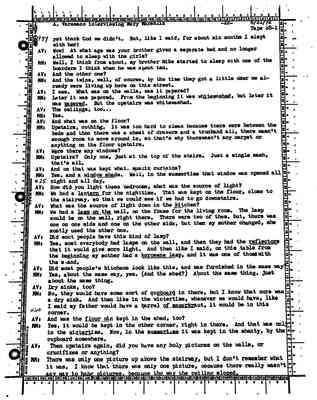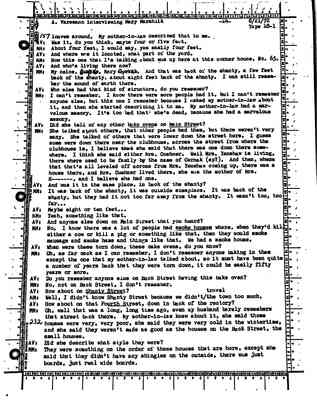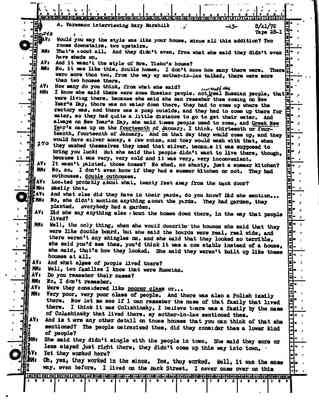Pages
23
A. Varesano interviewing Mary Marshlik -21- 8/21/72 Tape 28-1
slept upstairs, because there were two babies, and if one was sleeping, the other one was awake! So, he said he had to go to work, so then he would sleep upstairs, so for quite a while he slept upstairs, and my sister and I slept downstairs. Now, upstairs, on...there would be two beds. There would be one bed right from the front here as you come up the stairs, on this side of the window. There was one bed right from the wall over this way. You couldn't put it too far here, because the roof came right down. So the one bed would be here, and then there'd be another bed right below it, there'd be a space in between, just enough to walk through. And then down at the end towards the neighbor's side there was a big trunk where my mother kept all things that she, well some of her personal possessions and things that she didn't want touched or anything, well, she kept in that trunk. And then there would be another just above the stairs... AV: Who slept in those two beds? MM: Well, the children used to sleep in these beds...my brothers and sisters...and then in this bed on this side where the stairway was, well it was the boarders that would sleep in there. AV: But there was no paertition between... MM: No partition. Nothing. There wasn't anything. AV: So, the kids used to sleep in the bedroom over the living room, and the boarders in the bedroom over the kitchen. MM: Right. AV: How many beds in that section over the kitchen? MM: One, just this one bed. And if we had two boarders, they both slept together. And if there was one boarder, well then, my brother would sleep with him. AV: How many kids of what age and such slept in this bedroom over the living room? MM: Over the living room, well, there were, up until, between my sister Helen and me there was six years difference because two children died in between there, so that there were three of us sleeping upstairs at one time, and then when my mother had the twins, then Helen came upstairs to sleep, so then there were four, and then when my sister Ronnie was born, well, then the twins came upstairs to sleep, so, but by that time my mother would only keep on boarder, by the time my youngest sister was born. AV: So your brother slept with the boarder. MM: Yes. Sometimes there were two of them, sometimes my older brother and one of the twins would sleep with the boarder. He didn't seem to mind, he was a very nice man. He just died recently, and he was a very nice man, and he didn't mind having the children sleep with him. AV: These twins were male twins? MM: Yes. So that's how we slept. My sister Anna and I, and then when Helen came up to sleep, we three slept on one bed. And sometimes, if there was there were less of us upstairs, well then maybe there were only two of us on a bed. And then at one time, my mother had her neice from New York, she was sick. It was a dangerous thing to do, now when I think about it, I don't know if my mother realized how dangerous it was. My cousin had TB, and the doctor told my aunt that she should come to Pennsylvania, that the air is better, because they lived in Brooklyn. And my grandmother lived in Light Haven at the time, and when Julia came, and she didn't like to stay my grandmother's because there weren't any small children. So my grandmother asked my mother is she would take her to our place. So I slept with Julia for quite a long time. And Julia was fifteen and a half years old when she died with TB. So, now when I think about it, they didn't realize how dangerous it was, but you know, one of us could have gotten TB from her, and
24
A. Varesano interviewing Mary Marshlik
yet thank God we didn't. But, like I said, for about six months I slept with her!
AV: Wow! At what age was your brother given a separate bed and no longer allowed to sleep with the girls?
MM: Well, I think from about, my brother Mike started to sleep with one of the boarders I think when he was about ten.
AV: And the other one?
MM: And the twins, well, of course, by the time they got a little older we already were living up here on this street.
AV: I see. What was on the walls, was it papered?
MM: Later it was papered. But the upstairs was whitewashed.
AV: The ceilings, too...
MM: Yes.
AV: And what was on the floor?
MM: Upstairs, nothing. It was too hard to clean because there between the beds and then there was a chest of drawers and a trunk and all, there wasn't enough room to move around in, so that's why there wasn't any carpet or anything on the floor upstairs.
AV: Were there any windows?
MM: Upstairs? Only one, just at the top of the stairs. Just a single sash, that's all.
AV: And on that was kept what, muslin curtains?
MM: Yes, and a window shade. Well, in the summertime that window was opened all night and all day.
AV: How did you light these bedrooms, what was the source of light?
MM: We had a lantern for the nighttime. That was kept on the floor, close to the stairway, so that we could see if we had to go downstairs.
AV: What was the source of light in the kitchen?
MM: We had a lamp on the wall, right there. There were two of them, but, there was one on one side and one on the other side, but then my mother changed, she mostly used the other one.
AV: Did most people have this kind of lamp?
MM: Yes, most everybody had lamps on the wall, and then they had the reflectors that it would give more light. And then like I said, on this table from the beginning my mother had a kerosene lamp, and it was one of those with the stand.
AV: Did most people's kitchens look like this, and was furnished in the same way?
MM: Yes, about the same way, yes. (And the shed?) About the same thing, just about the same thing.
AV: Dry sinks, too?
MM: No, they would have some sort of cupboard in there, but I know that ours was a dry sink. And then like in the wintertime, whenever we would have, like I said my father would have a barrel of sauerkraut, it would be in this corner.
AV: And was the flour bin kept in the shed, too?
MM: Yes, it would be kept in the other corner, right in there. And that was only in the wintertime. Now, in the summertime it was kept in the shanty, by the cupboard somewhere.
AV: Then upstairs again, did you have any holy pictures on the walls, or crucifixes or anything?
MM: There was only one picture up above the stairway, but I don't remember what it was. I know that there was only one picture, because there really wasn't any way to hang pictures, because the way the ceiling sloped.
25
A. Varesano interviewing Mary Marshlik -238/21/72 Tape 28-1
AV: Yeah, I see. And was there any other kind of decoration up in the bedroom?
MM: No, nothing.
AV: What did you have, just beds, that's it? No tables, side tables, chairs?
MM: There was one little table, all the way here in the corner. Just a little table, a little square table [underline little square table].
AV: And what was it used for?
MM: Well, sometimes if we didn't have a lantern on it, we had a lamp, well the lamp would be on that table. Or sometimes maybe there would be a little statue [underline statue] of some sort, or something or another, that's about all. There really wasn't anything much.
AV: Hmm. Gee. That's great.
MM: And then, like, on the . . . I still have, I can show you a dresser scarf that must be close to sixty years old.
AV: . . . an outside bake oven [underline outside bake oven], right?
MM: Yes.
AV: And they took a mound of dirt . . .
MM: Yes, and they first had it level, and then in the center of it they put four bricks.
AV: How high was this mound?
MM: Oh, it was quite high. It was all of six, seven feet high, the whole thing after it was finished. But, well, the mound of dirt was about waist high. And then they had the bricks in there, and then they either had stone or bricks up and made a square out of it, or if not they'd have that all, and I don't know what they used, didn't they use a clay, make a cement of clay and water or something to put in between the bricks and the stones. And then, on top of all this, then they would take and they'd put some more dirt (she takes time to chase a moth that has got in the house). They'd sort of round it off, and then on the front, they'd go to a blacksmith, and they'd have the blacksmith make a door, an iron door, and underneath they would have a hole made and in there they would build a fire.
AV: Underneath the door?
MM: Yeah, after they'd have it packed down real good, then they'd make a hole underneath, and then underneath is where they would put logs of wood, you know, big thick ones, and they would take and they would build a fire in there, and that would get the stones and the bricks real hot, and you baked your bread in there.
AV: And the door was not hinged in any way, it was just propped up there?
MM: No, no, it was on hinges somehow or another they had it on hinges, but, see there was a blacksmith working at the colliery [underline blacksmith working at the colliery]. They would tell him just what they wanted and how they wanted it, and they would have a hinge on there.
AV: Did they pay him for that?
MM: No, he would do it, more or less as a favor. If they'd bring him the piece of iron, most of the times it would be maybe from an old coal car, and they'd bring a piece of iron and then he'd shape it and he knew just what they wanted and would shape it for them and make it for them.
AV: And how big was the entire structure, how many feet would you say?
MM: Well, I would say it would be about six feet high, maybe a little bit more than six feet high. It was quite wide. It was, I would say, maybe about four, five feet wide, and in depth, about, well I know that when they would bake bread, they could easily bake ten loaves of bread at one time in there, so it was quite big inside, it was a couple of feet inward, because you could reach in with your hand all the way to the back that you'd turn your
26
A. Varesano interviewing Mary Marshlik -248/21/72 Tape 28-1
loaves around. My mother-in-law described that to me.
AV: Was it, do you think, maybe four or five feet.
MM: About four feet, I would say, yes easily four feet.
AV: And where was it located, what part of the yard.
MM: Now this one that I'm talking about was up here at this corner house, No. 65.
AV: And who's living there now?
MM: My neice [sp. niece], G?uyrko?[spelling unreadable] Mary G?yr??ko [spelling unreadable]. And that was back of the shanty, a few feet back of the shanty, about eight feet back of the shanty. I can still remember the mound of earth there.
AV: Who else had that kind of structure, do you remember?
MM: I can't remember. I know there were more people had it, but I can't remember anyone else, but this one I remember because I asked my mother-in-law about it, and then she started describing it to me. My mother-in-law had a marvelous memory. It's too bad that she's dead, because she had a marvelous memory.
AV: Did she tell of any other bake ovens [underline bake ovens] on Main Street [underline Main Street]?
MM: She talked about others, that other people had them, but there weren't very many. She talked of others that were lower down the street here. I guess some were down there near the clubhouse, across the street from where the clubhouse is, I believe that [underline or strikeout that] she said that there was one down there somewhere. I think she said either Mrs. Cushner. Well, Mrs. Yenshaw is living, there where used to be family by the name of Cernak (sp?). And then, where that that's all leveled off across from Mrs. Yenshaw coming up, there was a house there, and Mrs. Cushner lived there, she was the mother of Mrs. H_ _ _ _ _ _ _. and I believe she had one.
AV: And was it in the same place, in back of the shanty?
MM: It was back of the shanty, it was outside someplace. It was back of the shanty, but they had it not too far away from the shanty. It wasn't too, too far . . .
AV: Maybe eight or ten feet . . .
MM: Yeah, something like that.
AV: And anyone else down on Main Street that you heard?
MM: No. I know there was a lot of people had smoke houses [underline smoke houses] where, when they'd kill either a cow or kill a pig or something like that, then they would smoke sausage and smoke hams and things like that. We had a smoke house.
AV: When were these torn down, these bake ovens, do you know?
MM: Oh, as far back as I can remember, I don't remember anyone baking in them except the one that my mother-in-law talked about, so it must have been quite a number of years back that they were torn down, it could be easily fifty years or more.
AV: Do you remember anyone else on Back Street having this bake oven?
MM: No, not on Back Street, I don't remember.
AV: How about on Shanty Street [underline Shanty Street]?
MM: Well, I didn't know Shanty Street because we didn't/the town too much.
AV: How about on that Fourth Street [underline Fourth Street], down in back of the rectory?
MM: Oh, well that was a long, long time ago, even my husband barely remembers that street back there. My mother-in-law knew about it, she said those houses were very, very poor, she said they were very cold in the wintertime, and she said they weren't made as good as the houses on the Back Street, the small houses.
AV: Did she describe what style they were?
MM: They were something on the order of these houses that are here, except she said that they didn't have any shingles on the outside, there was just boards, just real wide boards.
27
A. Varesano interviewing Mary Marshlik -258/21/72 Tape 28-1
AV: Would you say the style was like your house, minus all this addition? Two rooms downstairs, two upstairs.
MM: That's about all. And they didn't even, from what she said they didn't even have sheds on.
AV: And it wasn't the style of Mrs. Timko's house?
MM: No, it was like this, double homes. I don't know how many there were. There were more than two, from the way my mother-in-law talked, there were more than two houses there.
AV: How many do you think, from what she said?
MM: I know she said there were some Russian people, not ??? that's the real Russian people, that were living there, because she said she can remember them coming on New Year's Day, there was no water down there, they had to come up where the rectory was, and there was a pump outside, and they had to come up there for water, so they had quite a little distance to go to get their water. And always on New Year's Day, she said these people used to come, and Greek New Year's [underline Greek New Year's] came up on the fourteenth of January [underline fourteeth of January]. I think, thirteenth or fourteenth, fourteenth of January. And on that day they would come up, and they would have silver money, a few coins, and they would wash with that, when they washed themselves they used that silver, because it was supposed to bring you luck! But she said that people didn't want to live there, though, because it was very, very cold and it was very, very inconvenient.
AV: It wasn't painted, those homes? No shed, no shanty, just a summer kitchen?
MM: No, no. I don't even know if they had a summer kitchen or not. They had outhouses, double outhouses [underline double outhouses].
AV: Located probably about what, twenty feet away from the back door?
MM: Easily that.
AV: And what else did they have in their yards, do you know? Did she mention . . .
MM: No, she didn't mention anything about the yards. They had garden, they planted. Everybody had a garden.
AV: Did she say anything else about the homes down there, in the way that people lived?
MM: Well, the only thing, when she would describe the houses she said that they were like double board, but she said that boards were real, real wide, and there weren't any shingles on, and she said that they looked so terrible, she said you'd see them, you'd think it was a cow stable instead of a house, she said, that's how they looked. She said they weren't built up like thise houses at all.
AV: And what class of people lived there?
MM: Well, two families I know that were Russian.
AV: Do you remember their names?
MM: No, I don't remember.
AV: Were they considered like poorer class [underline poorer class] or . . .
MM: Very poor, very poor class of people. And there was also a Polish family there. Now let me see if I can remember the name of that family that lived there. I think it was Colishinsky, I believe there was a family by the name of Colashinsky [spelled differently than in beginning of sentence Coli or Cola] that lived there, my mother-in-law mentioned them.
AV: And is there any other detail on those houses that you can think of that she mentioned? The people ostracized them, did they consider them a lower kind of people?
MM: She said they didn't mingle with the people in town. She said they more or less stayed just right there, they didn't come up this way into town.
AV: Yet they worked here?
MM: Oh, yes, they worked in the mines. Yes, they worked. Well, it was the same way even before. I lived on the Back Street. I never came over on this




